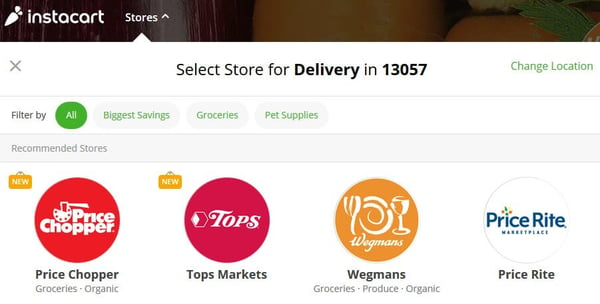In the current retail revolution, it’s hard to miss the many changes happening in the world of e-commerce. For grocery retailers in particular, one important trend is the rise of online grocery shopping, which includes websites and apps that offer delivery service and allow consumers to purchase grocery items from the comfort of their own homes.
Online grocery retail is a fast-growing industry. In fact, according to the Food Marketing Institute (FMI), consumers could be spending $100 billion per year on online grocery by 2022. For context, this amount is about equal to every U.S. household spending $850 annually for food and beverage online, and it’s estimated that as many as 70% of U.S. consumers will regularly purchase consumer packaged goods online in just five to seven years.
What’s more, FMI has found that these statistics are not exclusively derivative of younger shoppers: 41% of Baby Boomers have recently purchased consumer packaged goods online, compared to 61% of Millennials.

Of course, such a rapidly expanding market is going to involve high levels of competition – as evidenced by the current situation of many other online retail sectors. Shipt, Instacart, Amazon Prime Now and many others offer both websites and convenient apps that allow shoppers to order groceries online and either pick them up at a local grocery store or have their items delivered to their residence.
For grocery retailers that are moving into the online grocery market and want to excel by rising above competitors, it isn’t enough to simply get involved. Rather, success in the online grocery retail industry requires a smart product data management plan.
Why do online grocery retailers need to utilize optimized product data?
Let’s explore some of the reasons why robust, thorough product specifications and attributes are important for the online grocery retail industry in particular.
1. Effective product data management helps recreate the in-store grocery shopping experience
Grocery stores that offer an enjoyable in-store shopping experience aren’t exempt from the need to focus on quality product data when they expand into online grocery retail.
Let’s look at regional grocery chain Wegmans Food Markets as an example. Forbes recently argued that Wegmans is “hands down the most beloved supermarket in the country among its customers and employees,” citing the grocery stores' exciting atmosphere, high-quality, engaging product displays and overwhelming customer loyalty. In fact, Wegmans tied with Publix for first place on Market Force Information’s most recent Customer Loyalty Index that ranks grocery store chains across the country.
Clearly, Wegmans’ in-store shopping experience has won over the trust and loyalty of its customers. However, in order to experience the same level of success with their recent venture into online grocery retail by partnering with Instacart, Wegmans needs to focus on offering thorough product data that allows customers to make informed online grocery purchase decisions.
When shopping in a grocery store, customers often inspect product packaging, looking for details like nutritional information, ingredients lists and other specifics that let them know they’ve found the right product or they need to keep looking. Robust product attributes on an online grocery listing – whether that’s on a mobile app or a traditional website – need to offer the same type of information so customers can feel confident about adding items to their virtual cart. Multiple, large, high-quality product images also go a long way, since customers might recognize the product they’re looking for by viewing familiar packaging.
2. Thorough product attributes allow cross-selling of related items associated by recipes
Many grocery stores utilize product groupings in their in-store displays, such as including chocolate bars, marshmallows and graham crackers together in a summertime campfire s’mores end cap. This type of display strategy makes shopping easier and more convenient for customers while also encouraging a larger purchase.
With online grocery retail sites and apps, an effective product data management system can organize product attributes and product types to make cross-selling of related items simple. Cross-selling efforts benefit from organizing product listings according to recipes, giving consumers an intuitive shopping experience with less work trying to find desired products. Organizing product listings according to recipe ingredients can also help online grocery retailers compete with the growing popularity of meal kit services like HelloFresh and Blue Apron.
3. Ingredient-specific product attributes are important for specialty food categories
Product data that includes ingredient lists and specific nutritional information makes online grocery shopping much easier for customers interested in specialty food categories, like organic, gluten-free, vegan and vegetarian, as well as items that cater to individuals with food allergies. Product data management can also be utilized to organize products into entire sections devoted to these markets, helping customers find products even more intuitively, and giving your online grocery site or app an edge over competitors with less robust product information.
4. Thorough product information helps retailers stand out among local grocery competitors
Many online grocery apps and websites are linked with several local physical grocery stores where they source their product fulfillment. For example, Instacart suggests four different physical grocery locations within a nearby Central New York zip code:

If a consumer typically shops at only one or two nearby grocery store locations, using an online grocery delivery service can open up more shopping options, thereby increasing competition among the local grocery retailers listed. In order to stay competitive against grocery stores located all the way across town that are now being shopped by once-loyal customers, grocery retailers’ online components need to utilize optimized product data that will attract customers when they decide to order items online for home delivery.
Whether your retail grocery business hasn’t yet taken the leap into the world of e-commerce or you're not seeing the sales you expected, choosing a product data management service can make all the difference for your business and for your customers. Contact our team today to learn about how Virtucom Group's item onboarding service can optimize your online grocery offerings with robust product data and assets your customers are looking for.



.jpg)

